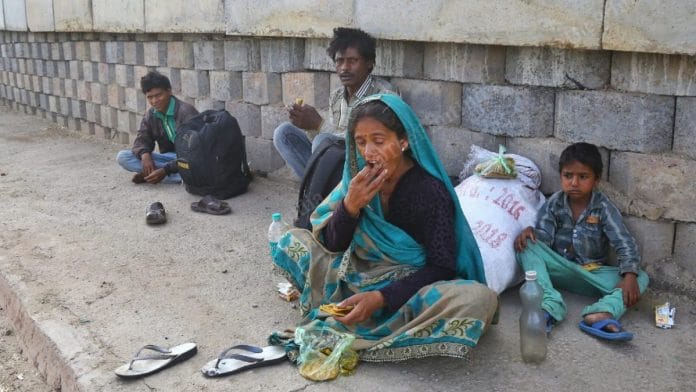Lack of job opportunities in rural areas forces thousands of economically challenged, aspirational youth to migrate to cities in search of livelihood. With empty pockets, hungry stomachs, growing families, and ailing parents, they leave their villages in hope of better jobs — only to face newer challenges in urban India.
Working and earning in a new city requires a roof over one’s head. Buying a house is out of the question for these economically weak labourers and migrants. Devoid of social capital and faced with a lack of affordable housing near their workplaces, they are forced to commute long distances.
According to the rates established by the Centre, the average minimum monthly wage in India varies between Rs 20,358 and Rs 26,910 — depending on the skill level. After spending more than Rs 13,000 on rent and commuting, and sending over Rs 7,000 back home to support their families, barely any money is left for survival.
While 30 percent of income is considered the ideal amount to spend on rent, Indians spend approximately 45-50 percent of their income on it, leaving just half their earnings to cover food, travel, nutrition, and medical expenses.
Mahesh, a migrant labourer from Jharkhand, says he sends Rs 7,000 to his family back home, pays Rs 8,000 for rent, and spends Rs 3,000 on commuting. Out of his income of Rs 23,000, he barely manages two meals a day.
Also read: RBI’s new gold loan guidelines could push borrowers back to moneylenders
The middle-class dilemma
Startling figures such as a Rs 23 lakh security deposit for a 4 BHK rental in Bengaluru, Rs 22,000 for a modest 1 BHK in Velachery, Chennai, and annual rental costs of Rs 5.18 lakh for a 1 BHK in Mumbai reflect the growing distress of the middle-class.
The sharp rise in rent, coupled with inflation in food and fuel prices, has become a spine-crushing burden. What used to be considered anomalies or outliers in the past are now symptoms of a much larger and growing crisis.
From January to June 2025, the rental growth rate in major metropolitan cities outpaced the national average. Metros like Pune, Mumbai, and Kolkata saw rental increases of more than 10 percent to the previous year. Delhi, Chennai, and Hyderabad have had more moderate hikes, according to data from Magicbricks. But the question remains: what are the pressing factors behind this rate hike, especially after Covid-19?
Reasons of increased rentals
The primary reason is the demand and supply dynamics that influence rental prices in metro cities. The perception of rising salaries in some sectors pushes up the overall cost of living, affecting even those who aren’t directly benefitting.
As one individual in Bengaluru put it, “Young techies lack street smartness and have high salaries.” They inadvertently drive the rent hikes, creating issues for people earning Rs 70,000-80,000. As demand rises but supply remains stagnant, prices continue to soar.
Undoubtedly, population growth and migration patterns play a huge role in driving demands. The migration of young talent from rural to urban areas in search of a better life is a major reason behind the rise in demand. For instance, in India’s Silicon Valley, reports say 185 people compete for one house — compared to just seven in Dubai.
Cyber hubs and technology parks are beehives for workers, which naturally drives up demand and rent in surrounding areas.
On the flip side, large-scale redevelopment and the construction of new societies to meet housing demand are displacing the poor, widening the inequality gap.
Also read: Make in India is a startup graveyard
Effect on society
The consequences are not limited to material discomfort. They have far-reaching psychological and social impacts.
Struggles for the middle class have increased multifold. Parting with a major chunk of income just to cover rent, food costs, education, childcare, and medical bills has completely drained people’s pockets.
Asha Kumari, who moved from Jharkhand to the Wazirpur Industrial Area in Delhi, shared a rented room with two other female workers. Within a year, the owner raised the rent per head from Rs 1,000 to Rs 2,200. She now lives in an unauthorised colony with no toilets and has to walk 10 minutes to reach pay-per-use facilities. Her health is deteriorating due to unhygienic conditions, but she can’t afford better. Government housing schemes remain inaccessible to her because she has no local ID proof or a residence certificate.
High rental costs have also led to the fragmentation of families, as the rising cost of living in cities forces many to leave their families behind in their native villages. This strains both affinal and filial relationships, creating ripple effects across society.
The need for policy intervention
In a functioning democracy, the least, the last, and the lowest must not merely survive, but thrive.
Policymakers must ensure that labourers, milkmen, newspaper vendors, and other essential workers do not have to sacrifice food just to keep a roof over their heads. These are the people who build our cities, keep them running, and connect us mile to mile, and yet they remain the most ignored section of society.
Urgent policy reforms are needed to encourage low-cost housing solutions. No one should have to choose between a roof and two meals. The real choice should be between dreams, not necessities.
Karti P Chidambaram is a Member of Parliament for Sivaganga, and a Member of the All India Congress Committee. His X handle is @KartiPC. Views are personal.
(Edited by Prashant)






